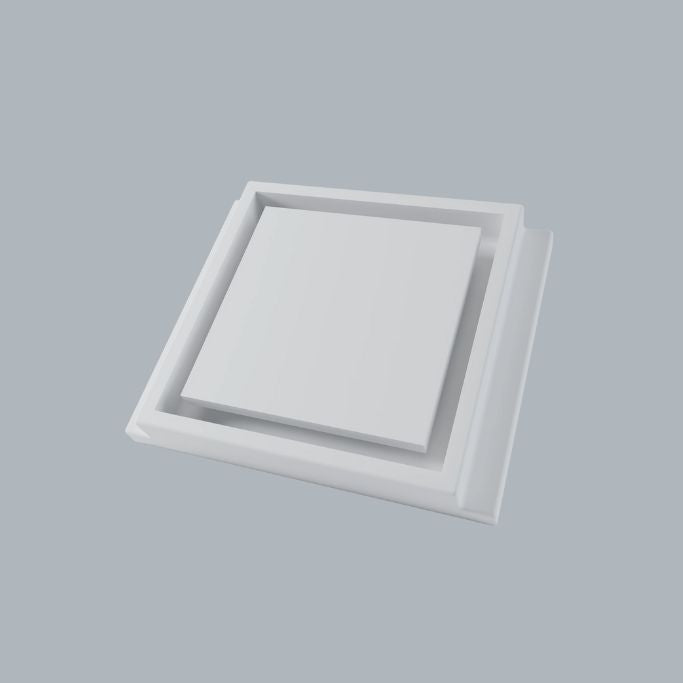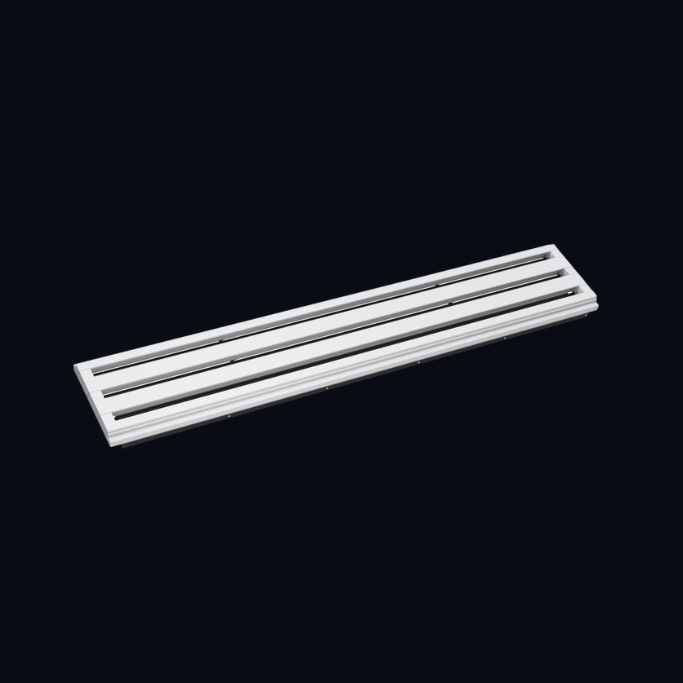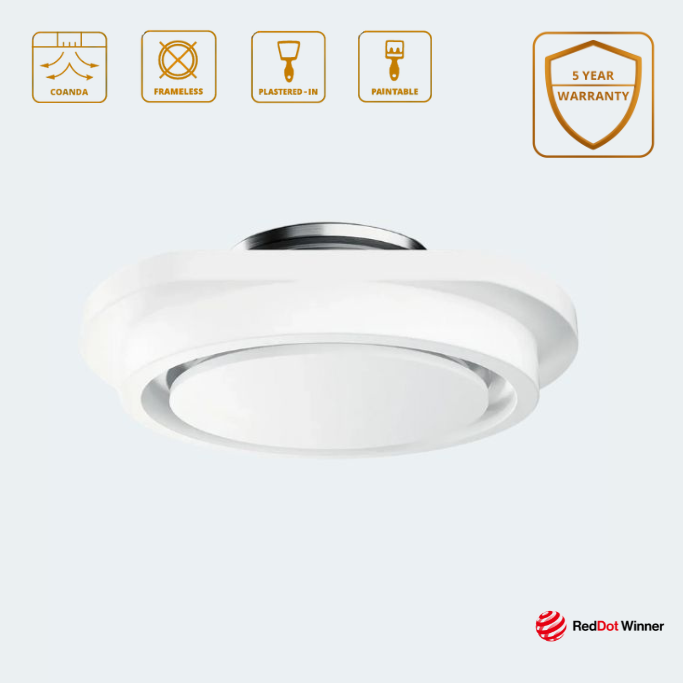Coanda Effect — Ventmann’s Innovation in Architectural Diffusers
At Ventmann, we believe that great ventilation design begins with science. One of the most powerful principles behind our diffuser technology is the Coanda Effect. This aerodynamic phenomenon transforms the way air moves within a room, ensuring comfort, efficiency, and elegance.
On this page, we will explain what the Coanda Effect is, how it functions in airflow dynamics, and why it is so essential for architectural diffusers. You will also learn how Ventmann has engineered this principle into our innovative products—most notably the Performance Circle Diffuser and Performance Line Diffuser.
If you value a balanced indoor climate, reduced energy consumption, superior acoustics, and seamless design integration, Ventmann’s approach to the Coanda Effect will show you how performance and architecture can work hand in hand.
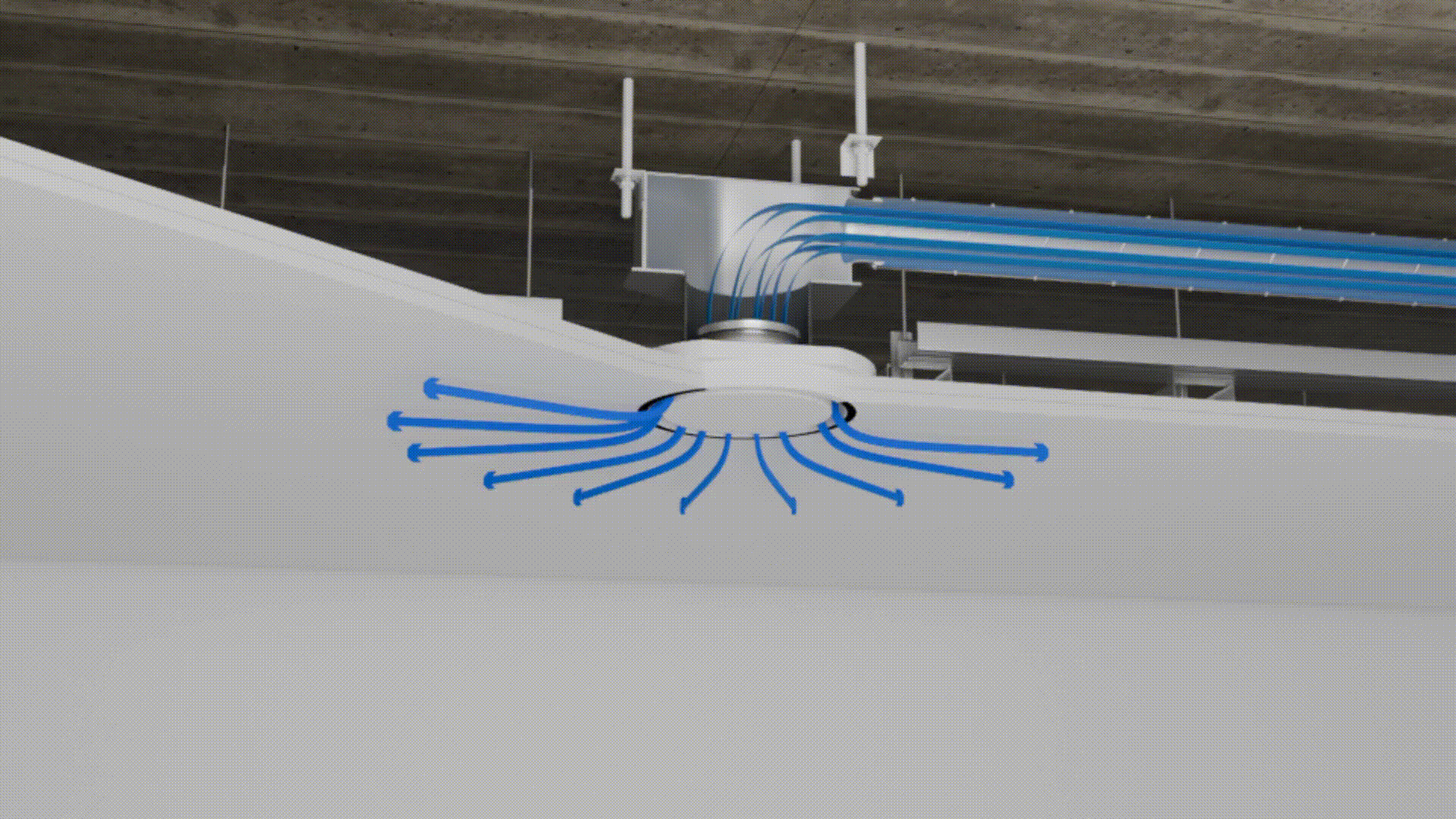
Ventmann’s Use of the Coandă Effect in Our Architectural Diffusers
At Ventmann, we specialise in architectural diffusers that not only look exceptional but optimise airflow by applying the Coandă Effect intelligently. Two of our key product lines are:
- Performance Circle Diffuser (also sold under the name PCIRCLE)
- Performance Line Diffuser (also known as PLINE)
These diffusers are engineered to deliver high performance, comfort, and aesthetic compatibility. Here’s how Ventmann uses the Coanda Effect in their design.
What Is the Coanda Effect?
The Coanda Effect (named after aeronautical engineer Henri Coanda) is a fluid dynamics principle describing the tendency of a jet of fluid—whether air or liquid—to adhere or “cling” to a nearby surface, even when that surface curves away from the initial path of the jet.
Key aspects of the Coanda Effect:
- Jet attachment: When a fluid emerges from an outlet (like an air diffuser) into a space, it tends to attach to adjacent surfaces (walls, ceilings etc.) under certain flow and surface conditions.
- Entrainment of surrounding fluid: The jet entrains air (or fluid) from its surroundings. This entrainment lowers pressure in nearby regions, encouraging the flow to follow surfaces.
- Influence of curvature and proximity: The shape, angle, distance of the surface from the outlet, and the velocity of the jet all affect how strongly the Coanda Effect is manifested. Sharp curves or surfaces too far away may reduce the effect.
Why the Coandă Effect Matters in Ventilation & Architectural Diffusers
In the context of air conditioning, heating, ventilation, and architectural diffusers, the Coandă Effect is leveraged to improve:
- Air distribution and comfort
When air is supplied via a diffuser near the ceiling or along a curved architectural surface, strong Coandă Effect causes the air to flow along that ceiling rather than dropping down as a direct jet. This spreads cooled (or heated) air more evenly, avoids drafts, and reduces stratification in the space. - Efficiency and energy savings
Because the airflow “hugs” surfaces and spreads further, you can use lower exit velocities, less fan power, and still achieve uniform temperature distribution. That means energy savings and quieter operation. - Aesthetic integration
Architectural diffusers designed with the Coandă Effect in mind can be more discreet, integrate seamlessly into ceilings (or walls), and enhance interior design without sacrificing performance. The airflow appears smooth and controlled. - Noise reduction
Higher velocities or turbulent flows tend to generate noise. By designing diffusers to use the Coandă Effect (spreading the flow and keeping it near surfaces), you reduce turbulence and noise. Also the velocity gradients are gentler.
Ventmann diffusers utilize the Coanda effect to optimize airflow distribution
How the Coanda Effect Works — The Mechanics
To understand how the Coanda Effect functions, it's useful to break down the fluid dynamics:
- A jet of air is forced out through an orifice or slot. If nothing is near, it spreads freely and entrains ambient air symmetrically.
- When a surface is placed near and adjacent (parallel or curved relative to the jet), that side prevents entrainment of ambient air, so there’s an imbalance: lower pressure between the jet and the surface.
- Because of this pressure difference, the jet gets pulled toward the surface and adheres to it. If the surface curves away, the air follows the curvature up to some limit (depending on flow speed, curvature radius, boundary layer, etc.).
- As the flow “sticks” to the surface, it spreads out over a larger area, mixing more with surrounding air (entrainment), thus reducing its momentum but increasing coverage.
Parameters that affect performance:
- Velocity and flow volume: Too low and the jet won’t adhere; too high and you might get separation or turbulence.
- Geometry of outlet (slot width, shape, angle): Defines where the jet starts and how it can attach.
- Distance from the surface: Closer is usually better for attachment but there are trade-offs.
- Surface shape and finish: Smooth, curved surfaces help; sharp corners or rough surfaces can reduce adherence.
Performance Circle Diffuser (PCIRCLE) — Coandă in Round Form
The Performance Circle Diffuser (Ventmann PCIRCLE) is a round, frameless diffuser designed to utilise the Coanda Effect across its circular perimeter.
Key design features:
- Curved annular outlet: The circular geometry provides a smooth, continuous outlet from which air is discharged around 360°. This encourages attachment along its curved annulus and helps airflow wrap gently into the ceiling boundary layer.
- Frameless aesthetics: With minimal visual interruption, the diffuser blends into ceiling surfaces, minimizing shadows or disruption. This also ensures the surface around the diffuser is smooth, which helps the Coandă Effect (less obstruction, fewer edges).
- Range of diameters (100-250 mm or more) allowing specification to ceiling height, room size, and required airflow. This allows Ventmann to tune how strongly the Coandă Effect works in each space. For example, at higher ceilings, larger diameter ensures the airflow stays attached longer before losing momentum.
Benefits from Coanda integration:
- Improved reach of airflow along ceilings, reducing cold downdrafts or hot spots.
- Lower noise and more gentle airflow, as the air moves along surfaces rather than being forced straight down.
- Design flexibility with a round shape that becomes an elegant architectural element.
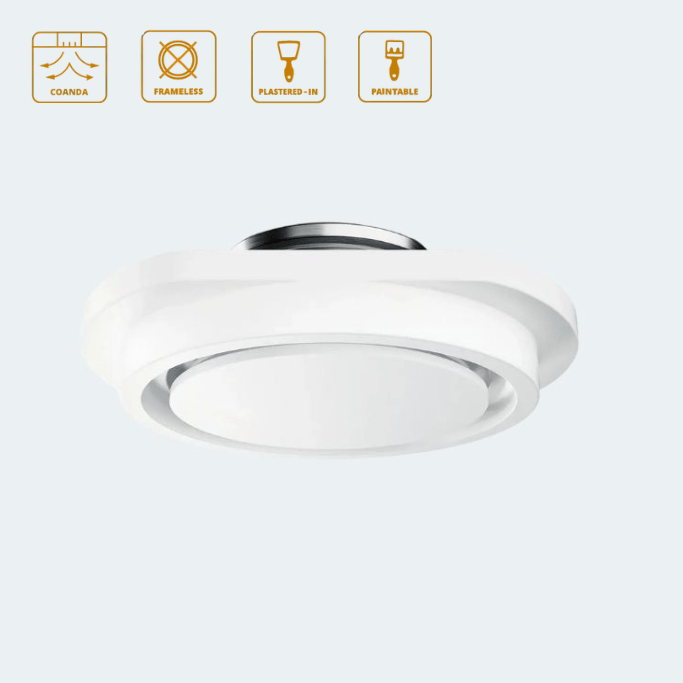
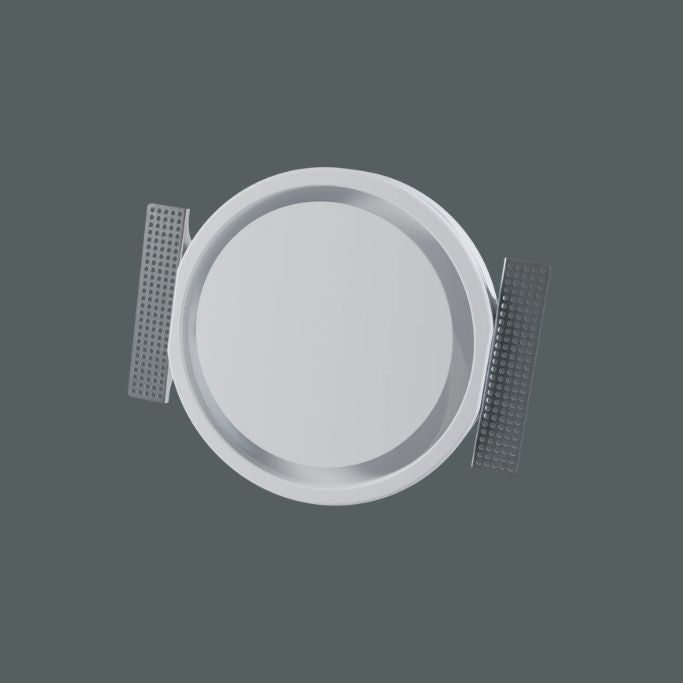
Performance Circle Diffusers
This innovation won Ventmann the coveted "reddot" design award. The Coanda effect means that the airflow adheres to the surrounding surface, allowing wider distribution of supply air and causing less perceptible air flow.
Why Ventmann Diffusers Are Unique in Their Use of the Coandă Effect
Ventmann brings several strengths in how it applies the Coanda Effect to architectural diffusers:
- Rigorous engineering: Our designs are tested and refined to ensure that the Coandă Effect is not just a marketing term, but performs in real-world indoor environments.
- Architectural sensitivity: We understand that diffusers are part of interior design. Ventmann’s Performance Circle and Performance Line are designed to blend aesthetics with functionality.
- Custom size options: We offer varying diameters, lengths, finishes so that the Coandă-based airflow can be tuned to each specific space, ceiling height, and room usage.
- Frameless or minimal frame design: Reducing obstruction around the outlet ensures that flow is less disturbed, allowing the Coandă Effect to manifest effectively.
Performance Line Diffuser (PLINE) — Linear Slot + Coandă Efficiency
The Performance Line Diffuser (Ventmann PLINE) is a linear or slot diffuser that also makes use of the Coanda Effect.
Key design features:
- Long, narrow slots: Air is discharged along linear slots that are generally parallel to the ceiling or wall. This slot geometry supports airflow that immediately begins interacting with the ceiling surface.
- Engineered flow paths: The internal design of the diffuser (slot geometry, internal vanes or flow guides) helps prevent separation, ensures even distribution across the slot, and supports laminar or low-turbulence flow where the Coandă Effect can take hold.
- Frameless or minimal frame design: Similar to the circle version, the minimal frame enables a clean junction with ceiling surfaces, reducing gaps and discontinuities which can disrupt the Coandă effect.
Ventmann itself describes the Performance Line diffuser as a “vent diffuser combines elegant and adaptable design features with specially engineered airflow that harnesses the Coanda effect.”
Benefits:
- Uniform airflow distribution along the length of the slot, avoiding “hot” or “cold” zones.
- Concealed and clean-looking channels, which make the diffuser almost invisible in modern or minimalist interiors.
- Efficiency in energy use: longer throw and more coverage, so HVAC systems can operate at lower pressures or lower fan settings.
- Enhanced acoustic comfort because the slot and attachment reduce turbulent noise.

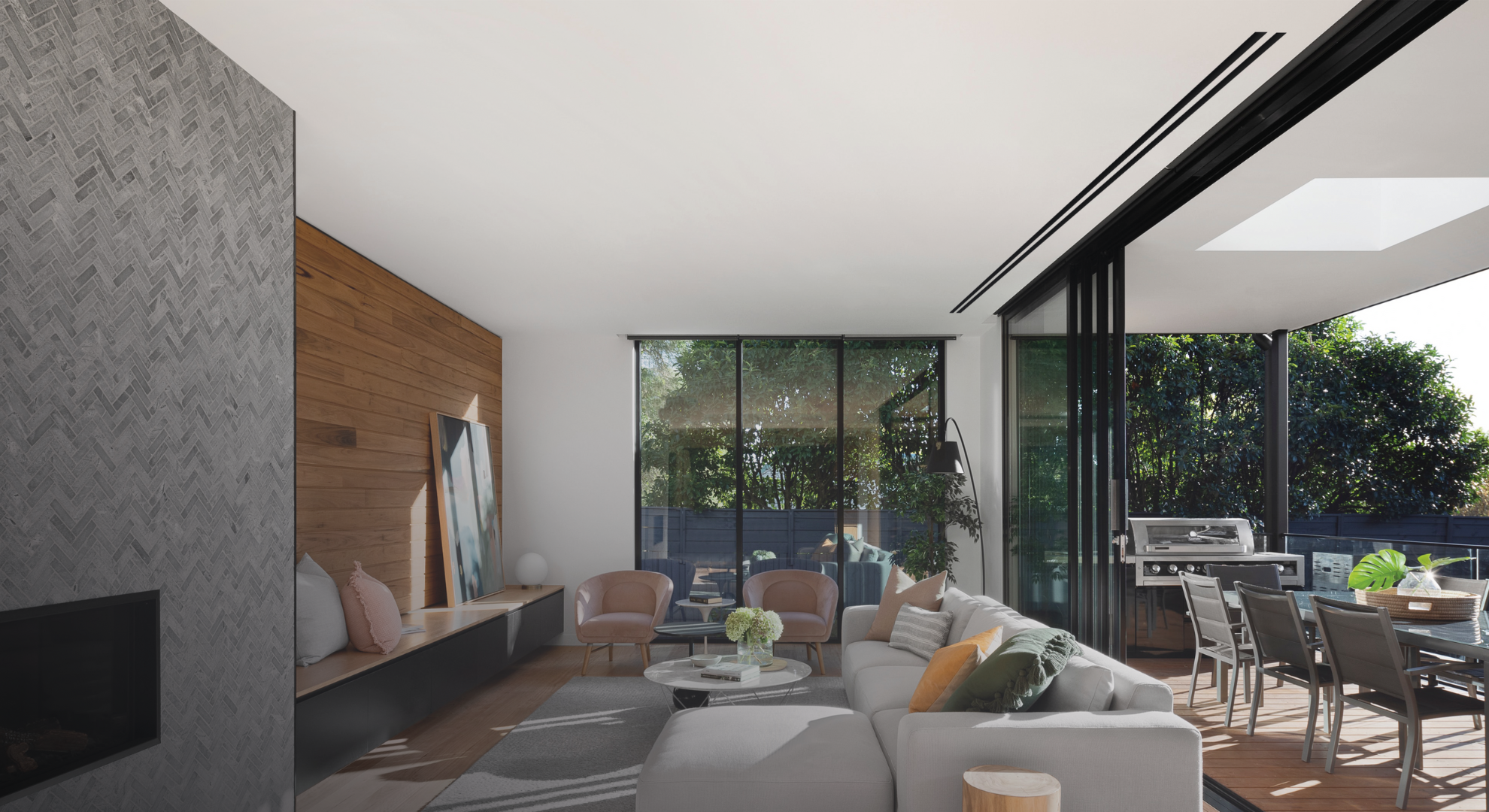
Performance Line Diffusers
We are very proud that the Ventmann Performance Linear Slot Diffuser won the coveted reddot award showing how innovative this product is. The curved inner faces of this grille allow the air to be directed either side of the unit and utilise the Coanda effect causing the airflow to adhere to the surrounding ceiling or wall. This allows a wide dispersal of air whilst reducing the perceptible airflow in the room.
The Coanda Effect is more than just aerodynamic theory—it is a foundational principle in delivering superior ventilation performance, especially when integrated into stunning architectural diffusers. At Ventmann, we harness this phenomenon in our Performance Circle and Performance Line diffusers to offer airflows that adhere to surfaces, spread evenly, reduce noise, and integrate beautifully into design.
If you are specifying ventilation systems or selecting diffusers for high-end architectural spaces, insist on diffusers with verified Coanda-based performance. Ventmann’s Architectural Diffusers are purpose-engineered for precisely that. Contact us to learn how to specify PCIRCLE or PLINE diffusers for your project, and to receive guidance on placement, sizing, and finishing to maximize the Coandă Effect in your space.
Blog posts

Ventmann UK to Exhibit at London Build Expo 2025 – The UK’s Largest Construction Show
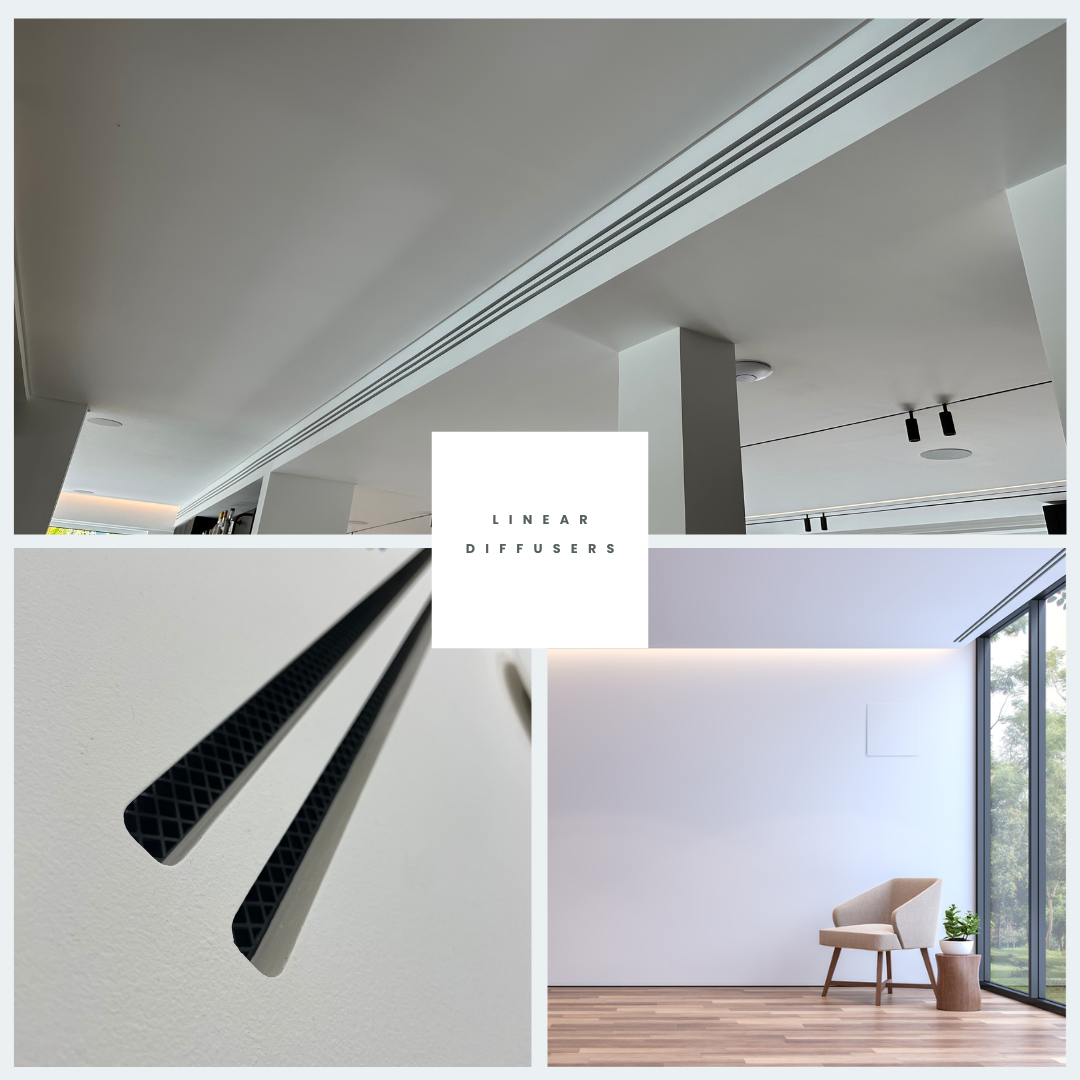
What Is a Linear Diffuser? Everything You Need to Know
In modern interior design and HVAC (Heating, Ventilation, and Air Conditioning) systems, linear diffusers have emerged as a go-to solution for spaces that demand both style and functionality.

Air Ventilation Grilles: Elegant Design Meets Engineering Performance
In today’s built environments, maintaining excellent indoor air quality is essential for health, comfort and regulatory compliance.

